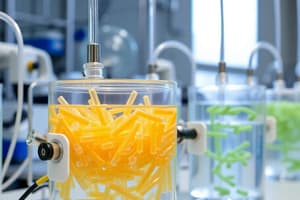Podcast
Questions and Answers
Which of the following are types of bioreactors? (Select all that apply)
Which of the following are types of bioreactors? (Select all that apply)
- Stirred tank bioreactor (correct)
- Gasoline engine
- Bubble column bioreactor (correct)
- Fluidized bed bioreactor (correct)
What is the primary purpose of a bioreactor?
What is the primary purpose of a bioreactor?
To provide an efficient environment for cells or enzymes to convert bio-chemicals into products.
Bioreactors can only be used for cell growth.
Bioreactors can only be used for cell growth.
False (B)
The part of a bioreactor that controls the pH is called the ______.
The part of a bioreactor that controls the pH is called the ______.
What parameters must be considered for a bioreactor to work well?
What parameters must be considered for a bioreactor to work well?
What is a common application of bioreactors?
What is a common application of bioreactors?
Study Notes
Overview of Bioreactors
- Bioreactors facilitate biochemical reactions by providing an optimal environment for whole cells or enzymes to convert substrates into desired products.
- They are also utilized in applications like water treatment to inactivate or sterilize cells.
Types of Bioreactors
- Stirred Tank Bioreactor: Commonly used for cell growth and enzyme production.
- Packed Bed Bioreactor: Suitable for processes involving immobilized cells.
- Fluidized Bed Bioreactor: Offers enhanced mass transfer rates and is used for heterogeneous reactions.
- Airlift Bioreactor: Promotes mixing through air bubbles, suitable for delicate cell cultures.
- Bubble Column Bioreactor: Utilizes gas bubbles to promote mixing, often used in fermentation processes.
Applications of Bioreactors
- Bioreactors are versatile, used in various fields including:
- Cell growth and maintenance
- Enzyme production and catalysis
- Food and beverage production, including milk processing
- Tissue engineering and regenerative medicine
- Protein synthesis and algae production
- Anaerobic digestion processes and chitinolytic cultures
Key Parameters for Bioreactor Efficiency
- Specific operational parameters are crucial for optimal bioreactor function:
- Temperature: Must be maintained within a range suitable for the target organism.
- Mixing Rate: Proper agitation ensures uniform nutrient distribution and prevents sedimentation.
- Nutrient Transfer: Adequate supply of nutrients is necessary for cell growth and activity.
- Gassing: Appropriate levels of oxygen or other gases must be provided, especially for aerobic processes.
Parts of a Bioreactor
- Various components work synchronously to create conducive conditions:
- Temperature Control: Regulates heater/cooler mechanisms.
- Nutrient Feed System: Supplies essential nutrients to the bioreactor.
- Aeration Device: Introduces gas into the culture medium.
- pH Control System: Maintains optimal acidity or alkalinity levels for biological processes.
Studying That Suits You
Use AI to generate personalized quizzes and flashcards to suit your learning preferences.
Description
Learn about the different types of bioreactors, their functions, and applications in industries such as water treatment and bio-chemical production.




